Microstructure, Hardness and High-Temperature Corrosion Behaviors in Sulfur-Containing Environment of Laser Cladding Y2O3/IN625 Composite Coating
Abstract
:1. Introduction
2. Materials and Methods
2.1. Coating Preparation
2.2. Microstructure Characterization
2.3. Hardness Testing
2.4. High-Temperature Sulfur-Containing Gas/Molten Corrosion Test
3. Results and Discussion
3.1. Microstructure Analysis
3.2. Hardness
3.3. High-Temperature Corrosion Behaviors in Sulfur-Containing Gas/Molten Salts
4. Conclusions
- The high-speed laser cladding Y2O3/IN625 composite coating is mainly composed of γ-Ni dendrites and an inter-dendritic structure; the addition of Y2O3 can effectively refine the microstructure, but not change the phase composition.
- The hardness of the Y2O3/IN625 composite coating can be improved by about 7.7% compared to the Inconel 625 coating, which is mainly attributed to the refined microstructure and strengthening effect of the Y2O3 particles.
- The laser cladding Y2O3/IN625 composite coating shows superior high-temperature corrosion resistance, with the mass gain decreased by about 36.6%. Y2O3 particles enhance the densification of the internal Cr-rich oxide layer and improve the interface bonding strength to the sample surface.
Author Contributions
Funding
Institutional Review Board Statement
Informed Consent Statement
Data Availability Statement
Conflicts of Interest
References
- Li, X.F. Corrosion behaviours two nickel-based coatings in H2S-containing environments. Surf. Coat. Technol. 2004, 183, 212–215. [Google Scholar] [CrossRef]
- Liu, C.; Liu, Z.; Gao, Y.; Zheng, C.; Wang, X. Investigation on the corrosion behavior of Ni-Cr-Mo-W-xSi laser cladding coating in H2S corrosion environment. Appl. Surf. Sci. 2021, 578, 152061. [Google Scholar] [CrossRef]
- Yu, X.; Gong, B.; Gao, Q.; Zhao, Y.; Tian, C.; Zhang, J. Zhang, Investigation of fireside corrosion at water-cooled wall from a coal-fired power plant in China. Appl. Therm. Eng. 2017, 127, 1164–1171. [Google Scholar] [CrossRef]
- Kumar, S.; Kumar, M.; Handa, A. Combating hot corrosion of boiler tubes—A study. Eng. Fail. Anal. 2018, 94, 379–395. [Google Scholar] [CrossRef]
- Singh, G.; Bala, N.; Chawla, V.; Singla, Y.K. Hot corrosion behavior of HVOF-sprayed carbide based composite coatings for boiler steel in Na2SO4-60% V2O5 environment at 900 °C under cyclic conditions. Corros. Sci. 2021, 190, 109666. [Google Scholar] [CrossRef]
- Padmini, B.; Bhosale, D.G.; Niranjan, H. A study of T11 boiler steel protection by cold sprayed Inconel 738 coating against high temperature erosion. Surf. Interfaces 2021, 23, 101002. [Google Scholar] [CrossRef]
- Szymański, K.; Hernas, A.; Moskal, G.; Myalska, H. Thermally sprayed coatings resistant to erosion and corrosion for power plant boilers—A review. Surf. Coat. Technol. 2015, 268, 153–164. [Google Scholar] [CrossRef]
- Singh, S.; Goyal, K.; Bhatia, R. A review on protection of boiler tube steels with thermal spray coatings from hot corrosion. In Proceedings of the International Conference on Materials, Machines and Information Technology (ICMMIT), Electr Network, Online, 24–25 January 2022; pp. 379–383. [Google Scholar]
- Singh, G.; Bala, N.; Chawla, V. High Temperature Oxidation Behaviour of HVOF Thermally Sprayed NiCrAlY Coating on T-91 Boiler Tube Steel. In Proceedings of the 6th International Conference on Materials Processing and Characterization (ICMPC), Melbourne, Australia, 5–7 December 2016; pp. 5259–5265. [Google Scholar]
- Varis, T.; Bankiewicz, D.; Yrjas, P.; Oksa, M.; Suhonen, T.; Tuurna, S.; Ruusuvuori, K.; Holmström, S. High temperature corrosion of thermally sprayed NiCr and FeCr coatings covered with a KCl-K2SO4 salt mixture. Surf. Coat. Technol. 2015, 265, 235–243. [Google Scholar] [CrossRef]
- Liu, X.; Hu, K.; Zhang, S.; Xu, T.; Chen, L.; Byon, E.; Liu, D. Study of KCl-induced hot corrosion behavior of high velocity oxy-fuel sprayed NiCrAlY and NiCrBSi coatings deposited on 12CrMoV boiler steel at 700 °C. Corros. Sci. 2022, 203, 110351. [Google Scholar] [CrossRef]
- Singh, J.; Vasudev, H.; Singh, S. Performance of different coating materials against high temperature oxidation in boiler tubes—A review. In Proceedings of the 10th International Conference of Materials Processing and Characterization (ICMPC), GLA Univ, Mathura, India, 21–23 February 2020; pp. 972–978. [Google Scholar]
- Jian, Y.; Liu, Y.; Qi, H.; He, P.; Huang, G.; Huang, Z. Huang, Effects of scanning speed on the microstructure, hardness and corrosion properties of high-speed laser cladding Fe-based stainless coatings. J. Mater. Res. Technol.-JmrT 2024, 29, 3380–3392. [Google Scholar] [CrossRef]
- Yang, Z.; Jian, Y.; Chen, Z.; Qi, H.; Huang, Z.; Huang, G.; Xing, J. Microstructure, hardness and slurry erosion-wear behaviors of high-speed laser cladding Stellite 6 coatings prepared by the inside-beam powder feeding method. J. Mater. Res. Technol.-JmrT 2022, 19, 2596–2610. [Google Scholar] [CrossRef]
- Wang, R.; Ouyang, C.; Li, Q.; Bai, Q.; Zhao, C.; Liu, Y. Study of the Microstructure and Corrosion Properties of a Ni-Based Alloy Coating Deposited onto the Surface of Ductile Cast Iron Using High-Speed Laser Cladding. Materials 2022, 15, 1643. [Google Scholar] [CrossRef] [PubMed]
- Gong, K.; Zheng, C.; Ju, D.; Ma, H.; Zhang, J. Corrosion of Ni-based alloy coatings prepared by laser cladding in high-temperature chloride environment. Surf. Coat. Technol. 2024, 484, 17620–17629. [Google Scholar] [CrossRef]
- Cheng, J.; Dai, Q.; Lan, W.; Zhou, X.; Yu, D. High-temperature corrosion behavior of the FeCrAl laser cladding coatings in waste-to-energy superheaters: Influence of Al content. Surf. Coat. Technol. 2024, 482. [Google Scholar] [CrossRef]
- Babu, M.S.; Kiruba, M.; Dharuman, N.; Sundaravignesh, S.; Sankarapandian, S.; Prabu, V.; Berchmans, L.J.; Sreedhar, G. High-temperature oxidation and hot corrosion behavior of Er2Sn2O7 + Inconel 625 composite. Ceram. Int. 2019, 45, 17620–17629. [Google Scholar] [CrossRef]
- Fantozzi, D.; Matikainen, V.; Uusitalo, M.; Koivuluoto, H.; Vuoristo, P. Chlorine-induced high temperature corrosion of Inconel 625 sprayed coatings deposited with different thermal spray techniques. Surf. Coat. Technol. 2017, 318, 233–243. [Google Scholar] [CrossRef]
- Guo, Q.; Li, Y.; Qian, J.; Yu, H.; Chen, C. Study of the pitting corrosion at welding joints of Inconel 625 alloy under high temperature and high H2S/CO2 partial pressure. Int. J. Electrochem. Sci. 2017, 12, 8929–8943. [Google Scholar] [CrossRef]
- Núñez, A.M.; Börjesson, E.; Kinnunen, H.; Lindberg, D.; Norling, R. Influence of PbCl2 and KCl salt mixture on high temperature corrosion of alloy 625. Fuel 2024, 358, 130196. [Google Scholar] [CrossRef]
- Pooja, M.; Ravishankar, K.; Madav, V. High temperature corrosion behaviour of stainless steels and Inconel 625 in hydroxide salt. In Proceedings of the 2nd International Conference on Smart and Sustainable Developments in Materials, Manufacturing and Energy Engineering (SME), Nitte, India, 22–23 December 2020; pp. 2612–2615. [Google Scholar]
- Wang, L.; Li, H.; Liu, Q.; Xu, L.; Lin, S.; Zheng, K. Effect of sodium chloride on the electrochemical corrosion of Inconel 625 at high temperature and pressure. J. Alloys Compd. 2017, 703, 523–529. [Google Scholar] [CrossRef]
- Xu, Z.; Guan, B.; Wei, X.; Lu, J.; Ding, J.; Wang, W. High-temperature corrosion behavior of Inconel 625 alloy in a ternary molten salt of NaCl-CaCl2-MgCl2 in air and N2. Sol. Energy 2022, 238, 216–225. [Google Scholar] [CrossRef]
- Yang, T.; Su, Y.; Su, M.; Dai, Z.; Wang, Y.; Liang, X. HOT corrosion behavior of inconel 625 cladding metal in KCl-MgCl2 molten salt. Mater. Today Commun. 2024, 38, 2612–2615. [Google Scholar] [CrossRef]
- Chen, L.; Zhang, X.; Wu, Y.; Chen, C.; Li, Y.; Zhou, W.; Ren, X. Effect of surface morphology and microstructure on the hot corrosion behavior of TiC/IN625 coatings prepared by extreme high-speed laser cladding. Corros. Sci. 2022, 201, 110271. [Google Scholar] [CrossRef]
- Ge, T.; Chen, L.; Gu, P.; Ren, X.; Chen, X. Microstructure and corrosion resistance of TiC/Inconel 625 composite coatings by extreme high speed laser cladding. Opt. Laser Technol. 2022, 150, 107919. [Google Scholar] [CrossRef]
- Zhang, X.; Sun, Y.; Yu, G.; Chen, C.; Ren, X.; Chen, L. Microstructural evolution and high-temperature oxidation of TiC/IN625 coatings fabricated by multi-layer extreme high-speed laser cladding. Opt. Laser Technol. 2023, 158, 108838. [Google Scholar] [CrossRef]
- Lin, F.; Wang, Z.; Xu, X.; Luo, K.; Lu, J. The effect of Y2O3 nanoparticle addition on the microstructure and high-temperature corrosion resistance of IN718 deposited by extreme high-speed laser cladding. Surf. Coat. Technol. 2024, 476, 130235. [Google Scholar] [CrossRef]
- Wang, C.; Gao, Y.; Wang, R.; Wei, D.; Cai, M.; Fu, Y. Microstructure of laser-clad Ni60 cladding layers added with different amounts of rare-earth oxides on 6063 Al alloys. J. Alloys Compd. 2018, 740, 1099–1107. [Google Scholar] [CrossRef]
- Bhatnagar, S.; Mullick, S. A study on the influence of reinforcement particle size in laser cladding of TiC/Inconel 625 metal matrix composite. Opt. Laser Technol. 2023, 161, 109115. [Google Scholar] [CrossRef]
- Xu, P.; Tang, X.; Yao, S.; He, J.; Xu, G. Effect of Y2O3 addition on microstructure of Ni-based alloy + Y2O3 substrate laser clad. J. Mater. Process. Technol. 2008, 208, 549–555. [Google Scholar] [CrossRef]
- Xu, Z.; Yuan, J.; Wu, M.; Arif, A.F.M.; Li, D. Effect of laser cladding parameters on Inconel 718 coating performance and multi-parameter optimization. Opt. Laser Technol. 2023, 164, 108850. [Google Scholar] [CrossRef]
- Lou, L.-Y.; Liu, K.-C.; Jia, Y.-J.; Ji, G.; Wang, W.; Li, C.-J.; Li, C.-X. Microstructure and properties of lightweight Al0.2CrNbTiV refractory high entropy alloy coating with different dilutions deposited by high speed laser cladding. Surf. Coat. Technol. 2022, 447, 128873. [Google Scholar] [CrossRef]
- Cao, Z.; Jian, Y.; Yao, X.; Deng, J.; Zhou, Y.; Wang, J.; Huang, Z. Dual effects of Cr doping on the high-temperature oxidation behavior of Mo2FeB2-based cermets. Corros. Sci. 2022, 205, 110358. [Google Scholar] [CrossRef]
- Liebhard, M.; Levy, A. The Effect of Erodent Particle Characteristics on the Erosion of Metals. Wear 1991, 151, 381–390. [Google Scholar] [CrossRef]
- Feng, K.; Chen, Y.; Deng, P.; Li, Y.; Zhao, H.; Lu, F.; Li, R.; Huang, J.; Li, Z. Improved high-temperature hardness and wear resistance of Inconel 625 coatings fabricated by laser cladding. J. Mater. Process. Technol. 2017, 243, 82–91. [Google Scholar] [CrossRef]
- Kotan, H.; Darling, K.A.; Scattergood, R.O.; Koch, C.C. Influence of Zr and nano-Y2O3 additions on thermal stability and improved hardness in mechanically alloyed Fe base ferritic alloys. J. Alloys Compd. 2014, 615, 1013–1018. [Google Scholar] [CrossRef]
- Zhang, Q.; Wang, Q.; Han, B.; Li, M.; Hu, C.; Wang, J. Comparative studies on microstructure and properties of CoCrFeMnNi high entropy alloy coatings fabricated by high-speed laser cladding and normal laser cladding. J. Alloys Compd. 2023, 947, 169517. [Google Scholar] [CrossRef]
- Sundaresan, C.; Rajasekaran, B.; Varalakshmi, S.; Santhy, K.; Rao, D.S.; Sivakumar, G. Comparative hot corrosion performance of APS and Detonation sprayed CoCrAlY, NiCoCrAlY and NiCr coatings on T91 boiler steel. Corros. Sci. 2021, 189, 109556. [Google Scholar] [CrossRef]
- Xu, Q.-L.; Zhang, Y.; Liu, S.-H.; Li, C.-J.; Li, C.-X. High-temperature oxidation behavior of CuAlNiCrFe high-entropy alloy bond coats deposited using high-speed laser cladding process. Surf. Coat. Technol. 2020, 398, 126093. [Google Scholar] [CrossRef]
- Quadakkers, W.J.; Holzbrecher, H.; Briefs, K.G.; Beske, H. Differences in Growth Mechanisms of Oxide Scales Formed on Ods and Conventional Wrought Alloys. Oxid. Met. 1989, 32, 67–88. [Google Scholar] [CrossRef]
- Bhuyan, P.; Sanyal, S.; Mitra, R.; Mandal, S. Grain size dependant high-temperature hot corrosion (HTHC) degradation behavior in Alloy 617 during exposure in Na2SO4 + NaCl + V2O5 salt mixture. J. Alloys Compd. 2022, 914, 165262. [Google Scholar] [CrossRef]
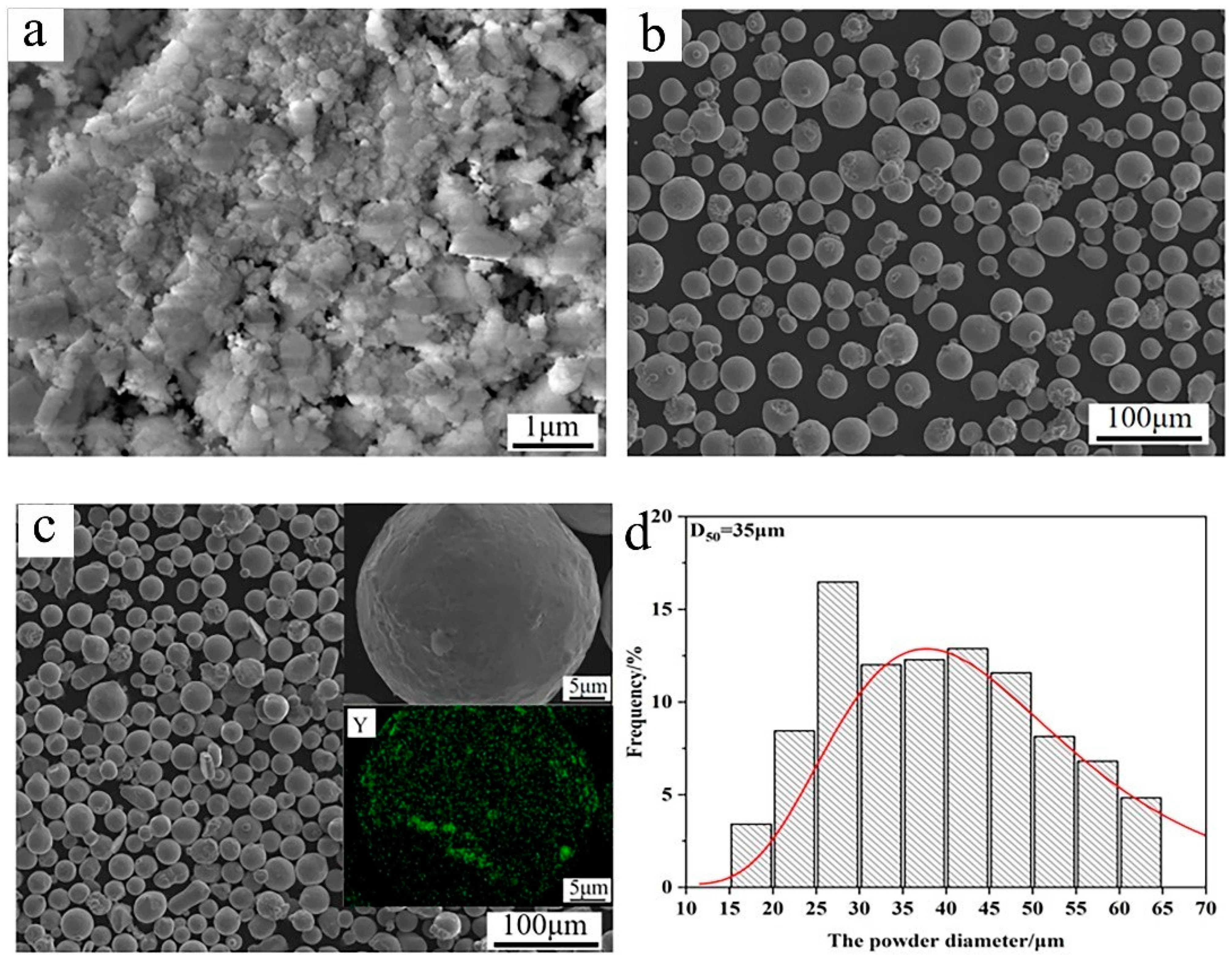


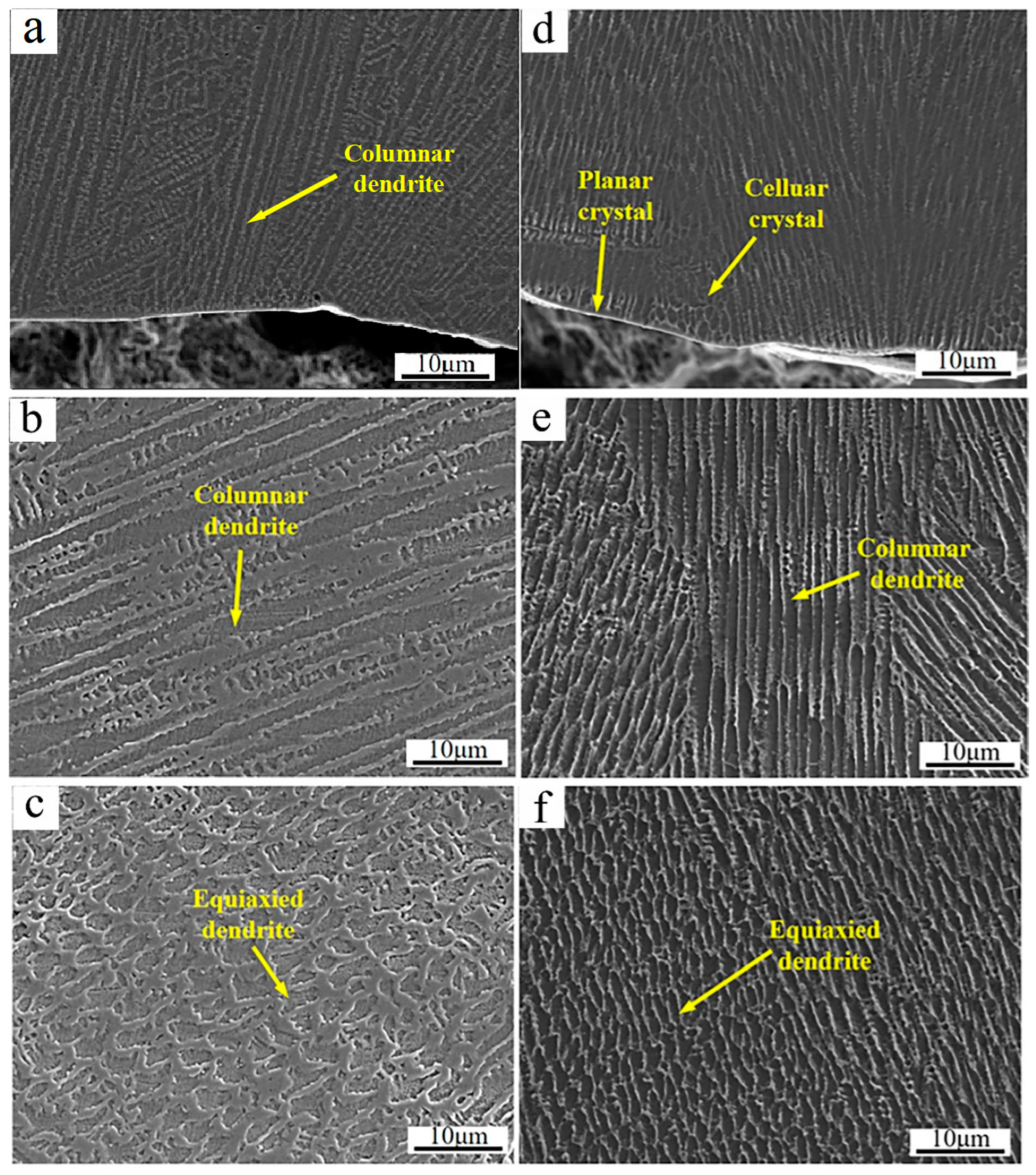
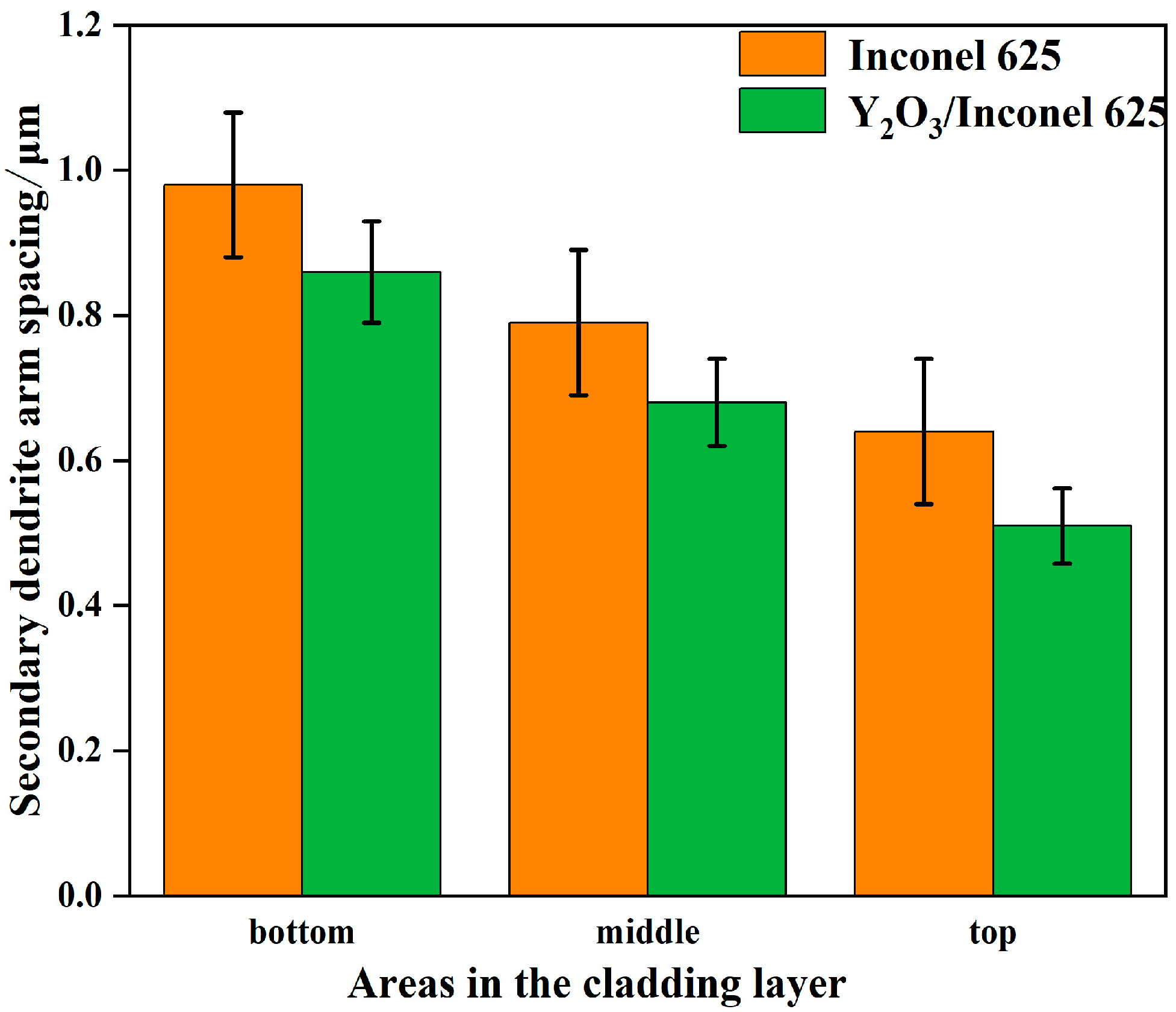
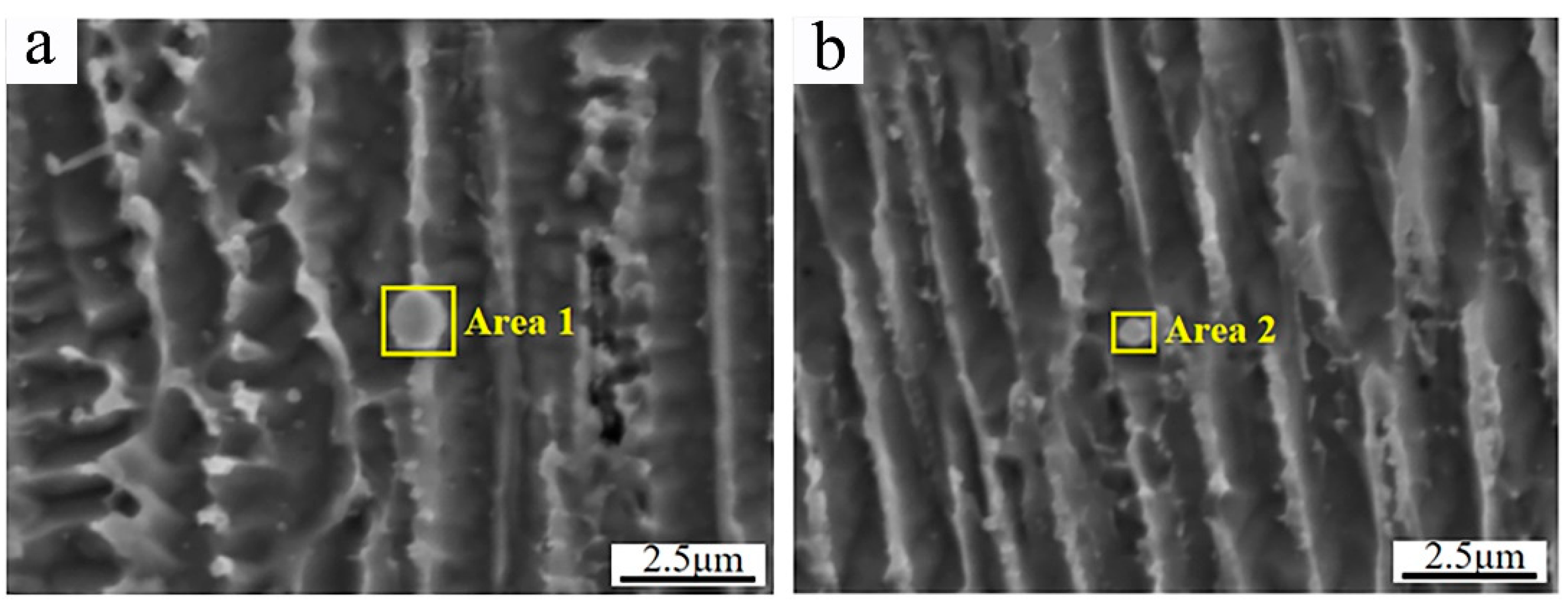
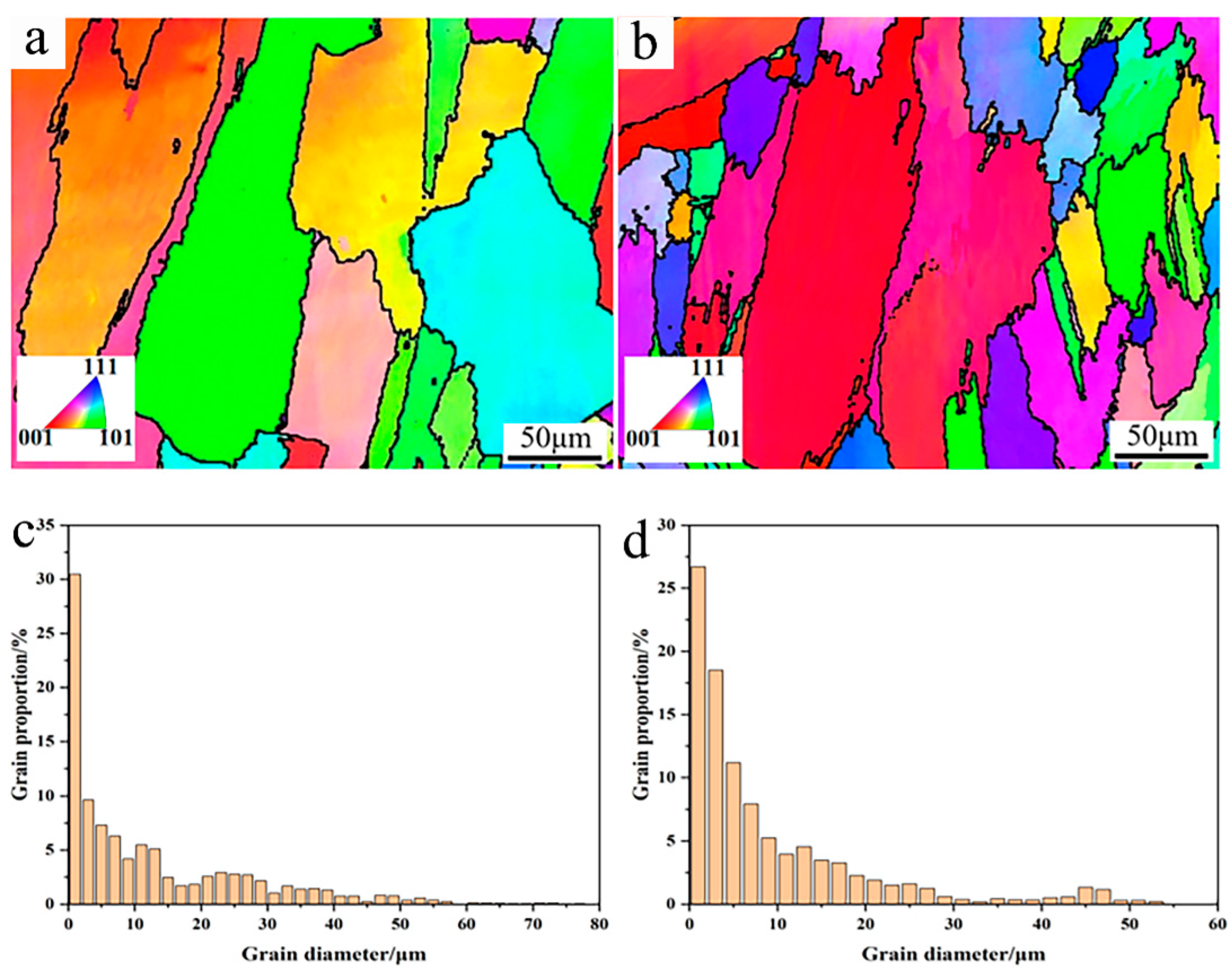
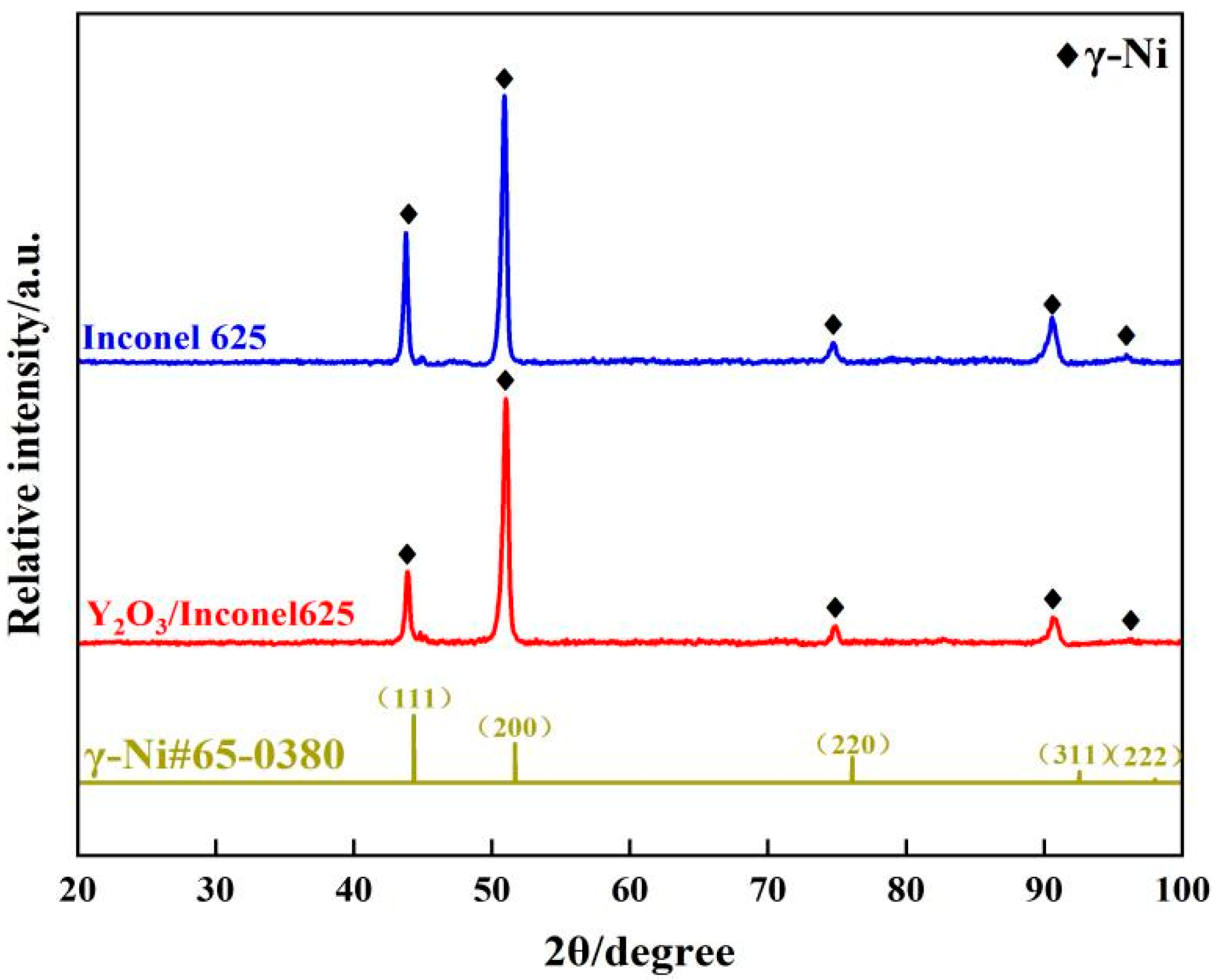
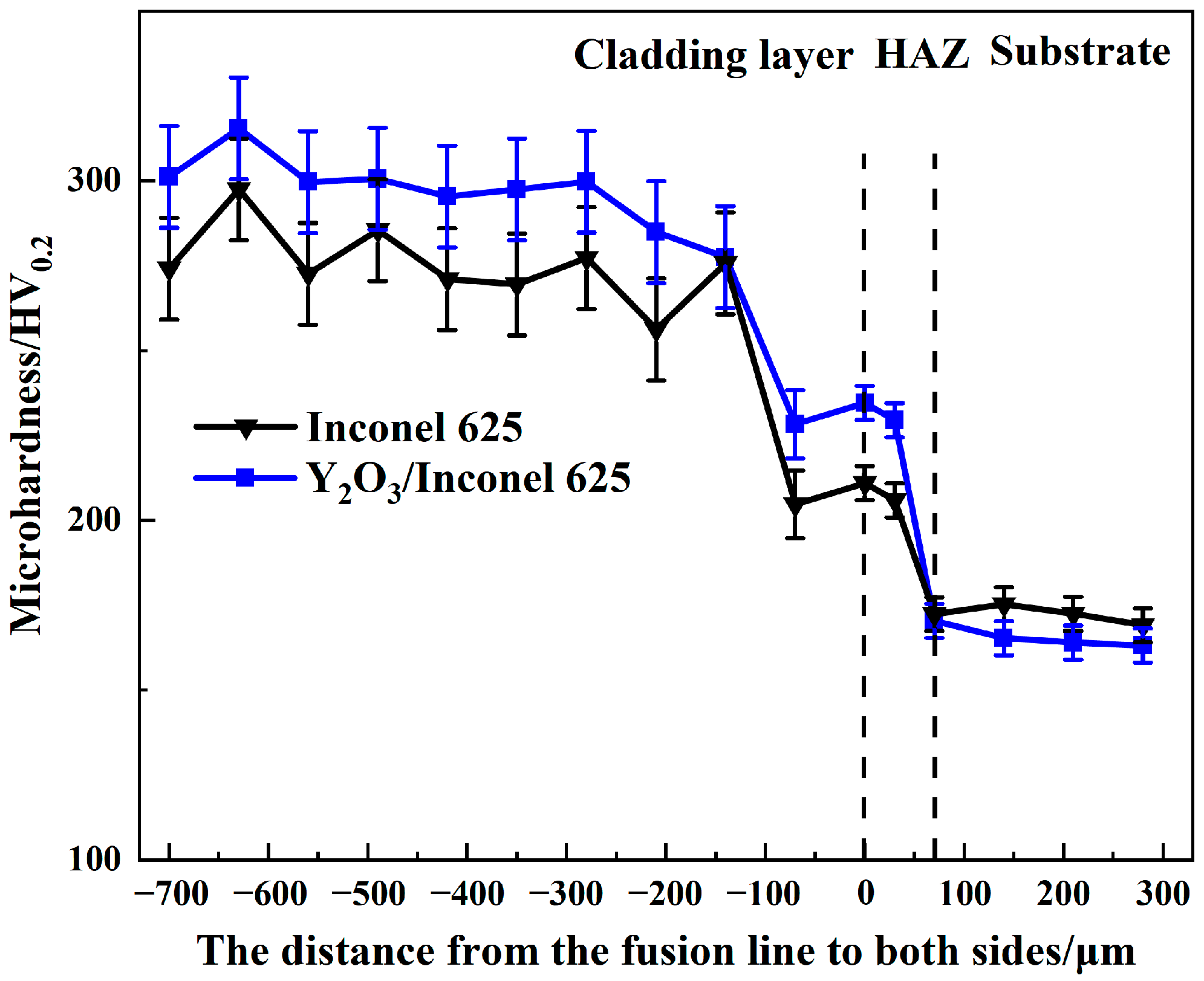

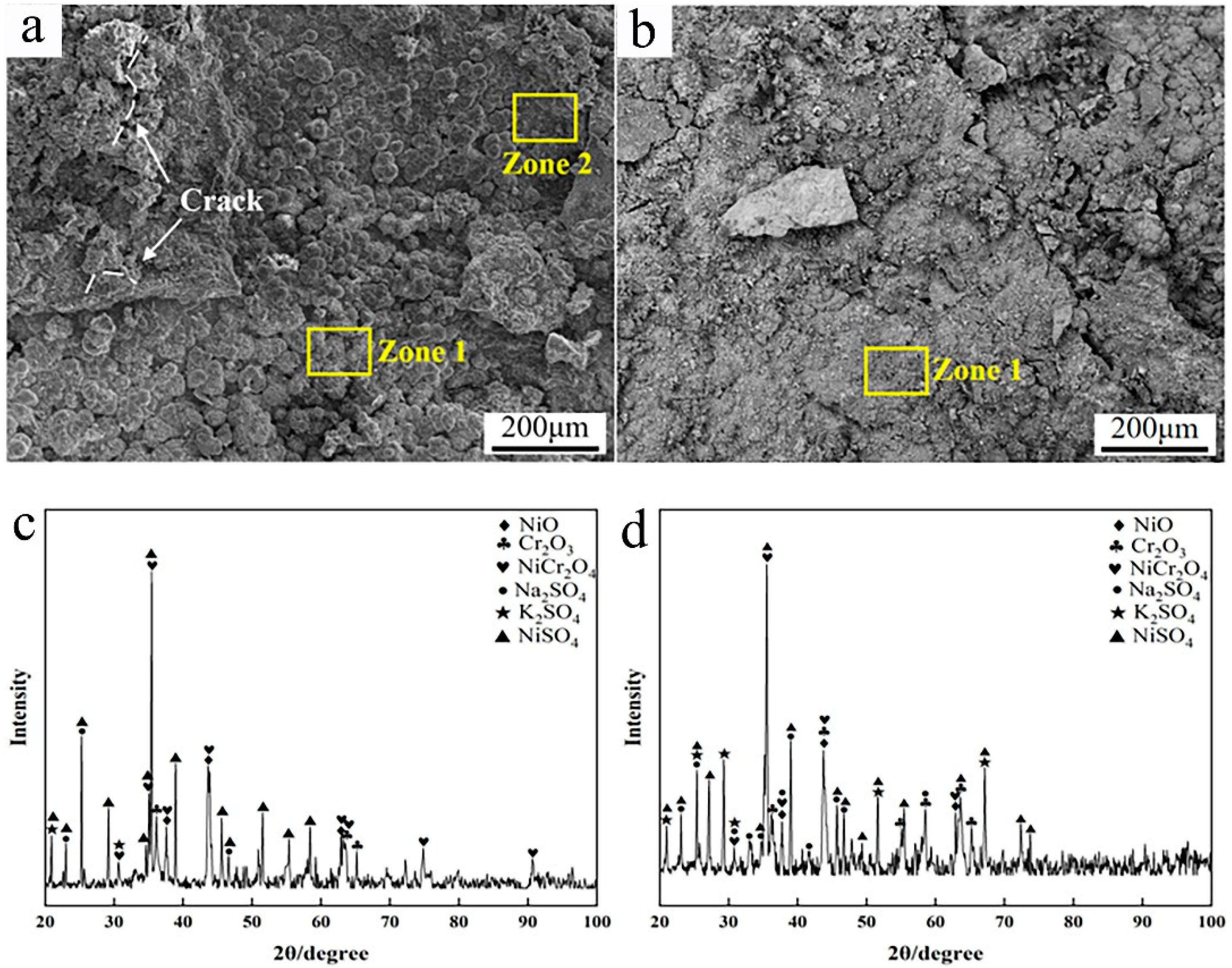
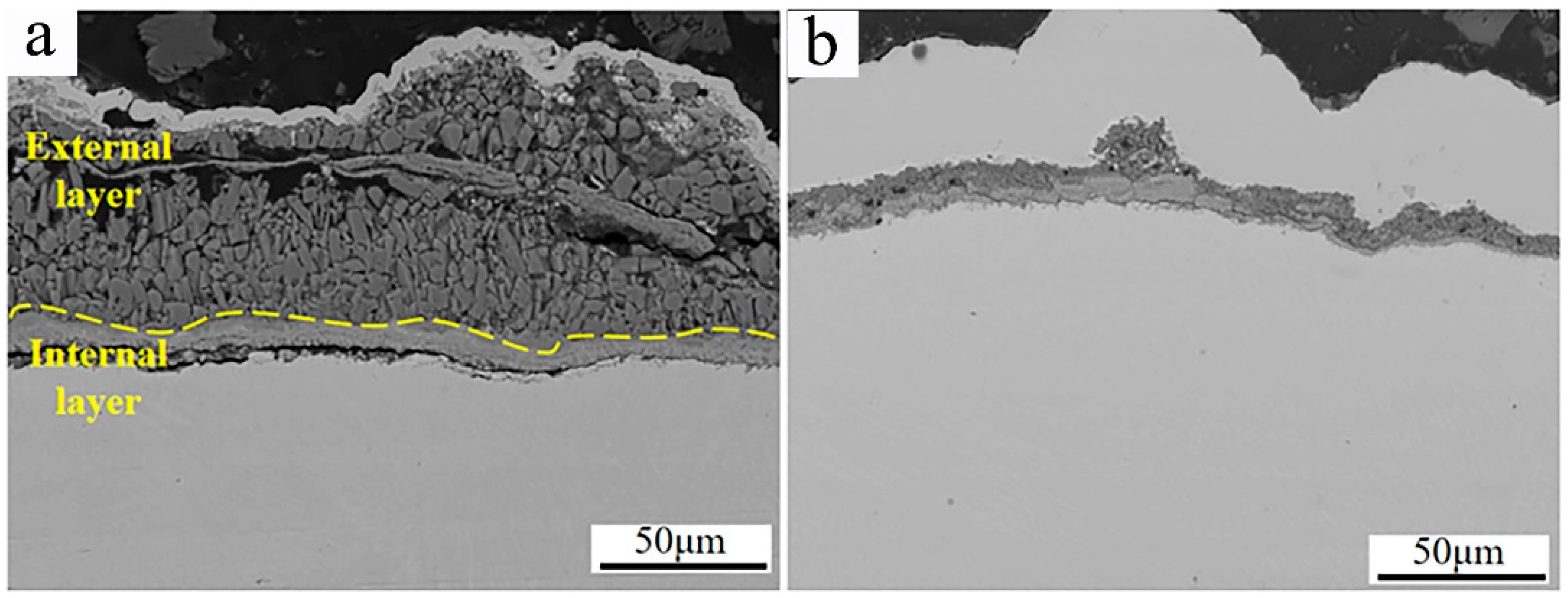

| Cr | Ni | Mn | Si | Nb | C | Fe |
|---|---|---|---|---|---|---|
| 17.39 | 9.08 | 1.29 | 0.49 | 0.48 | 0.043 | Bal. |
| Laser Power/W | Scanning Speed/mm·min−1 | Powder Feeding Rate /g·s−1 | Feeding Powder Gas /L·min−1 | Overlapping Rate /% |
|---|---|---|---|---|
| 3000 | 3000 | 0.30 | 5 | 80 |
| Species | N2 | CO2 | O2 | SO2 |
|---|---|---|---|---|
| Ratio | 81.25 | 14.9 | 3.6 | 0.25 |
| Regions | Ni | Cr | Mo | Nb | Fe | Al | Y | O |
|---|---|---|---|---|---|---|---|---|
| Area 1 | 36.25 | 19.50 | 5.62 | 7.18 | 6.77 | 9.08 | 3.79 | 11.81 |
| Area 2 | 40.12 | 18.04 | 6.32 | 4.94 | 6.73 | 9.79 | 2.36 | 11.70 |
| Elements | Ni | Cr | Mo | Nb | Fe | Al | O | S |
|---|---|---|---|---|---|---|---|---|
| External layer | 23.39 | 0.39 | / | / | 0.60 | / | 60.94 | 14.68 |
| Internal layer | 4.72 | 29.48 | 5.12 | 1.86 | 1.05 | 0.32 | 47.72 | 9.73 |
| Elements | Ni | Cr | Mo | Nb | Fe | Al | Y | O | S |
|---|---|---|---|---|---|---|---|---|---|
| Area 1 | 19.83 | 0.24 | - | - | 0.16 | 0.13 | 0 | 60.84 | 18.80 |
| Area 2 | 1.96 | 25.97 | 4.59 | 1.87 | 0.17 | 0.33 | 0.33 | 52.49 | 12.29 |
Disclaimer/Publisher’s Note: The statements, opinions and data contained in all publications are solely those of the individual author(s) and contributor(s) and not of MDPI and/or the editor(s). MDPI and/or the editor(s) disclaim responsibility for any injury to people or property resulting from any ideas, methods, instructions or products referred to in the content. |
© 2024 by the authors. Licensee MDPI, Basel, Switzerland. This article is an open access article distributed under the terms and conditions of the Creative Commons Attribution (CC BY) license (https://creativecommons.org/licenses/by/4.0/).
Share and Cite
Li, Y.; Zheng, H.; Chang, Z.; Liu, F.; Wang, Y.; Jian, Y. Microstructure, Hardness and High-Temperature Corrosion Behaviors in Sulfur-Containing Environment of Laser Cladding Y2O3/IN625 Composite Coating. Materials 2024, 17, 4837. https://doi.org/10.3390/ma17194837
Li Y, Zheng H, Chang Z, Liu F, Wang Y, Jian Y. Microstructure, Hardness and High-Temperature Corrosion Behaviors in Sulfur-Containing Environment of Laser Cladding Y2O3/IN625 Composite Coating. Materials. 2024; 17(19):4837. https://doi.org/10.3390/ma17194837
Chicago/Turabian StyleLi, Yong, Hao Zheng, Zhe Chang, Fuguang Liu, Yansong Wang, and Yongxin Jian. 2024. "Microstructure, Hardness and High-Temperature Corrosion Behaviors in Sulfur-Containing Environment of Laser Cladding Y2O3/IN625 Composite Coating" Materials 17, no. 19: 4837. https://doi.org/10.3390/ma17194837







